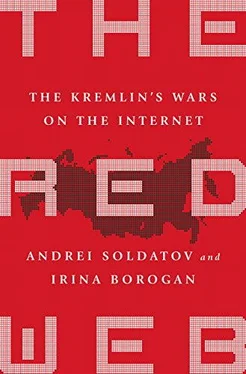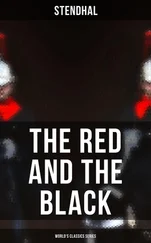It was a bright victory for Leviev’s team: the system of technical filtering had gaps, and Leviev thought about how to exploit them, not to harass Roskomnadzor but to keep Navalny’s blog online.
They set up a domain, navalny.us, with lots of subdomains—the technical mechanism of blocking does not block all subdomains. Leviev called for help: on the site of navalny.us he posted instructions on how to make a subdomain, and urged people to make them and send word to Navalny. Over sixty volunteers responded, many with several subdomains, and Leviev got a network of 150 to 200 possible subdomains, ready to go.
The system became known as the “Big Red Button of Navalny”—the user gets to navalny.us, sees a big red button, pushes it, and it leads him or her to one of the subdomains. Navalny’s blog survives.
Next Leviev went to war against Roskomnadzor’s censors. He figured out how to identify who inside the agency was responsible for the search-and-destroy missions against Navalny and others. [12] Ruslan Leviev, interview with authors, August 2014.
In April Leviev published a large post with a scheme, logs, and detailed explanations of who was in charge inside of Roskomnadzor for checking the blocked sites. [13] Leviev’s post on LiveJournal, “Kak rabotaet mechanism blokirovok Roskomnadzora” [How the Mechanism of Blocking by Roskomnadzor Works], April 22, 2014, http://ruslanleviev.livejournal.com/34401.html .
By exposing them, he made their lives difficult, often trapping them into long, pointless dead ends. When the censors came to work and started to check whether the Navalny blog was working, their screens were filled with images of cats and ponies—a wicked retaliation.
Leviev was pleasantly surprised one day when Roskomnadzor officials acknowledged to the newspaper Vedomosti that they saw a cat instead of Navalny’s blog. [14] Ksenia Boletskaya, “Roskomnadzoru pokazivayut kotyat vmesto saita Navalnogo” [Roskomnadzor Is Shown Kittens Instead of the Site of Navalny], Vedomosti , April 21, 2014, www.vedomosti.ru/technology/articles/2014/03/21/roskomnadzoru-pokazyvayut-kotyat-vmesto-sajta-navalnogo .
It was a triumph—a rare one—for the digital revolutionaries. Despite all of Roskomnadzor’s efforts, Navalny’s blog was alive and accessible, and no one needed special software like Tor to access the site.
Leviev was sitting in the offices of TV Dozhd in the Red October compound when he told Irina about his success in evading the censors. Leviev’s small company, Newscaster, was broadcasting online from an antiwar street demonstration in Moscow for TV Dozhd. Newscaster provided the broadcast to TV Dozhd for free because Leviev thought its content was important. The TV Dozhd premises were almost deserted because the channel was on the move after having come under constant pressure. In the patriotic hysterics that were already evident in January 2014, TV Dozhd was accused of being unpatriotic for conducting a controversial online poll that asked viewers whether Leningrad, now St. Petersburg, should have been surrendered to the Nazis in 1941 in order to spare its citizens the mass agony of a brutal nine-hundred-day siege. The poll took place on Sunday, January 26, a day before the seventieth anniversary of the lifting of the siege. Pro-Kremlin bloggers immediately attacked the channel, and in thirty minutes Ilya Klishin, now editor of the channel’s site, removed the poll and apologized for the wording. On Monday Putin was in St. Petersburg to take part in official celebrations. [15] “70th Anniversary of Lifting of Siege of Leningrad,” Kremlin.ru, January 27, 2014, http://eng.kremlin.ru/news/6573 .
He was on his way to the Piskarev cemetery where his brother, who had died during the blockade, is buried, when he was shown the TV Dozhd poll. [16] Natalia Sindeeva, interview with authors, August 2014.
On January 27 Sindeeva, the founder of TV Dozhd, was sitting in her glass office at Red October. She started getting calls and e-mails from viewers that the channel was going off the air in different regions. A cable operator, who said it was his patriotic duty to throw TV Dozhd off his package, began the attack, and soon others followed. [17] Natalia Krainova and Anna Dolgov, “Cable Providers Drop Independent Dozhd TV Amid Pressure,” Moscow Times , January 29, 2014, www.themoscowtimes.com/news/article/cable-providers-drop-independent-dozhd-tv-amid-pressure/493576.html . See also Will Englund, “Russian TV Channel Takes Flak Just for Asking: ‘Should Leningrad Have Surrendered?’” Washington Post , January 30, 2014, www.washingtonpost.com/world/europe/russian-tv-channel-takes-flak-just-for-asking-should-leningrad-have-surrendered/2014/01/30/c1455812–89c0–11e3–833c-33098f9e5267_story.html .
By then TV Dozhd was present in 18 million homes and enjoyed a monthly audience of 12 million viewers. Every day an estimated 1.1 million people watched it. The audience in regions was on the rise, and Sindeeva’s contacts told her that the presidential administration was worried about the growth in viewers; TV Dozhd had ceased being just a Moscow hipster’s thing. Some operators called Sindeeva and explained that they got phone calls from the Kremlin and could not resist the pressure. [18] Sindeeva, interview, August 2014.
“It was a snowball,” Sindeeva said. When, on January 29, Putin’s spokesperson Dmitry Peskov said, “TV Dozhd crossed the line of the permissible,” all other cable operators followed suit and switched off TV Dozhd. [19] “Peskov: telekanal Dozhd pereshev vse grani dopustimogo” [Peskov: TV Dozhd Crossed the Line of the Permissible], Interfax, January 29, 2014, www.interfax.ru/russia/354742 .
The channel lost millions of viewers—its lifeline.
Sindeeva desperately tried to find a way to get the channel back on cable. The channel held a press conference, and Sindeeva talked about the pressure. She asked for a personal meeting with Putin and was initially told that Putin agreed. However, Volodin intervened, and the meeting never happened. Journalists of the channel went to Putin’s press conferences and asked questions about the fate of TV Dozhd, and on April 17 Putin said something encouraging but it led nowhere. [20] “Putin—Dozhdu: Ya sdelayu vse, chtobi izbavit vas ot izbitochnogo vnimania kontroliruyushikh organov” [Putin—Dozhd: I’ll Do Anything to Save You from Excessive Attention to Regulatory Bodies], TV Dozhd, April 17, 2014, http://tvrain.ru/articles/putin_dozhdju_ja_sdelaju_vse_chtoby_izbavit_vas_ot_izbytochnogo_vnimanija_kontrolirujuschih_organov-367069 .
In June a TV Dozhd reporter tried again, but the result was the same. Putin simply shrugged, “I don’t know who gave the command to switch you off from the cable, I didn’t give such a command.” [21] “Putin—Dozhdu: I ne daval kommandu kabelshikam prekrashat rabotu s vami” [Putin—Rain, I Did Not Command Cable Manufacturers to Stop Working with You], TV Dozhd, June 6, 2014, http://tvrain.ru/articles/putin_dozhdju_ja_ne_daval_komandu_kabelschikam_prekraschat_rabotu_s_vami-369587 .
It looked like a déjà vu—his words echoed his meeting with NTV journalists in January 2001.
From this time forward TV Dozhd was available only on the Internet. It lost many advertisers, and Sindeeva was forced to introduce a paid model for TV Dozhd content.
In March TV Dozhd got a letter from its headquarters’ landlord: in a few months they were to be expelled from its premises on Red October, the symbol of the modernized hipsters of Medvedev’s time. For some months journalists of TV Dozhd had to broadcast from their apartments. But they broadcast nevertheless. [22] The TV Dozhd staff found the new premises only in 2015, at the former factory of Flakon.
Читать дальше












